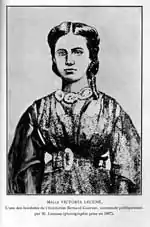Institute Catholique
The Institute Catholique, also known as L'Institut Catholique des orphelins indigents (Catholic Institute for Indigent Orphans),[1] and the Couvent School,[2] was a school founded in the Faubourg Marigny district of New Orleans in 1840 dedicated to providing a free education to African-American orphans. It was the first school in the United States to offer a free education to African-American children. It also served the non-orphan children of free people of color ("gens de couleur libre"), who paid a modest tuition.

Founding
The school was financed from a trust established in the will of Madame Marie Couvent, the African-American widow of Bernard Couvent, one of the most commercially successful free men of color in New Orleans. The concept of educating African-Americans was opposed by some members of the white community in New Orleans, and the establishment of the trust for the school was challenged in court. The widow died in 1837, and when the original executor of the will failed to forcefully implement its terms, a group of ten leading Afro-Creole intellectuals residing in New Orleans formed The Catholic Institute for the Instruction of Indigent Orphans. This group successfully sued in court to obtain control of the widow's estate. The courts did not finally rule in favor of this group until 1846.
The charter authorizing the Institute Catholique to function as a corporation was received from the state of Louisiana in 1847, and the school opened in 1848, renting facilities in the Fauborg Marigny suburb just east of the French Quarter while awaiting construction of a permanent building on the land donated by Madame Couvent. Félice Coulon Cailloux, wife of André Cailloux, later a hero in the American Civil War, initially served as the principal of the school while it operated in temporary quarters.
By 1850, the city of New Orleans had a population of approximately 150,000. Of this population, 15,000 were free people of color, and 15,000 were slaves. The city had a three tier social structure, at the top of which were free whites, in the middle were free people of color, and at the bottom were slaves. Free people of color could own property, own businesses, and enter contracts, but could not vote, marry whites, or send their children to the public schools of the city, which were established in 1841. This rankled the French inspired republican idealism of the Afro-Creole intelligentsia, many of whom had been educated in France.
The permanent building of the Institute Catholique was completed in 1852. The Afro-Creole poet Armand Lanusse (1810–1867), editor of and contributor to Les Cenelles, a book of French poetry written by Afro-Creoles, who had been instrumental in the founding of the school and was one of the ten original board members, was named headmaster in 1852. He continued in that capacity until his death in 1867.
Andre Cailloux and his wife, Félicie Coulon Cailloux, were active supporters of the school throughout the 1850s, sending all three of their surviving children there for instruction. Félicie continued to work at the Institute for several years after Lanusse became headmaster, and was responsible for the well being of the 75 young orphan girls who attended.
Though the school's property and building were provided for in the will of Madame Couvent, the income generated from the real estate included in her estate was insufficient to cover annual operating expenses. The gap was made up through charitable contributions from several mutual aid societies established within the Afro-Creole community of New Orleans. The Friends of Order, an Afro-Creole mutual aid society of which Cailloux was a member, organized an annual contribution collected by its members at the cemeteries of New Orleans each year on All Soul's Day (November 2). Other mutual aid societies held annual charity balls. Occasionally, the school received small appropriations from the City of New Orleans and the State of Louisiana.
Average annual enrollment during the 1850s was approximately 300.
References
- A Black Patriot and a White Priest by Stephen J. Ochs 2006
- Daggett, Melissa (2016). Spiritualism in Nineteenth-Century New Orleans: The Life and Times of Henry Louis Rey. Univ. Press of Mississippi. p. 16. ISBN 9781496810113. Retrieved 25 February 2018.
Books
- Bell, Carolyn Coss, Revolution, Romanticism, and the Afro-Creole Protest Tradition in Louisiana, 1718-1868, LSU Press, 2003.
- Desdunes, Rodolphe Lucien, Our People and Our History: Fifty Creole Portraits, LSU Press, 1973, Translated from the 1911 French original by Sister Dorothy Olga McCants.
- Medley, Keith W. We As Free Men: Plessey v. Ferguson, Pelican Publishing, 2003.
- Medley, Keith W, The Will of the Widow Couvent, Preservation in Print, 1999.
- Ochs, Stephen, A Black Patriot and a White Priest, LSU Press, 2001.